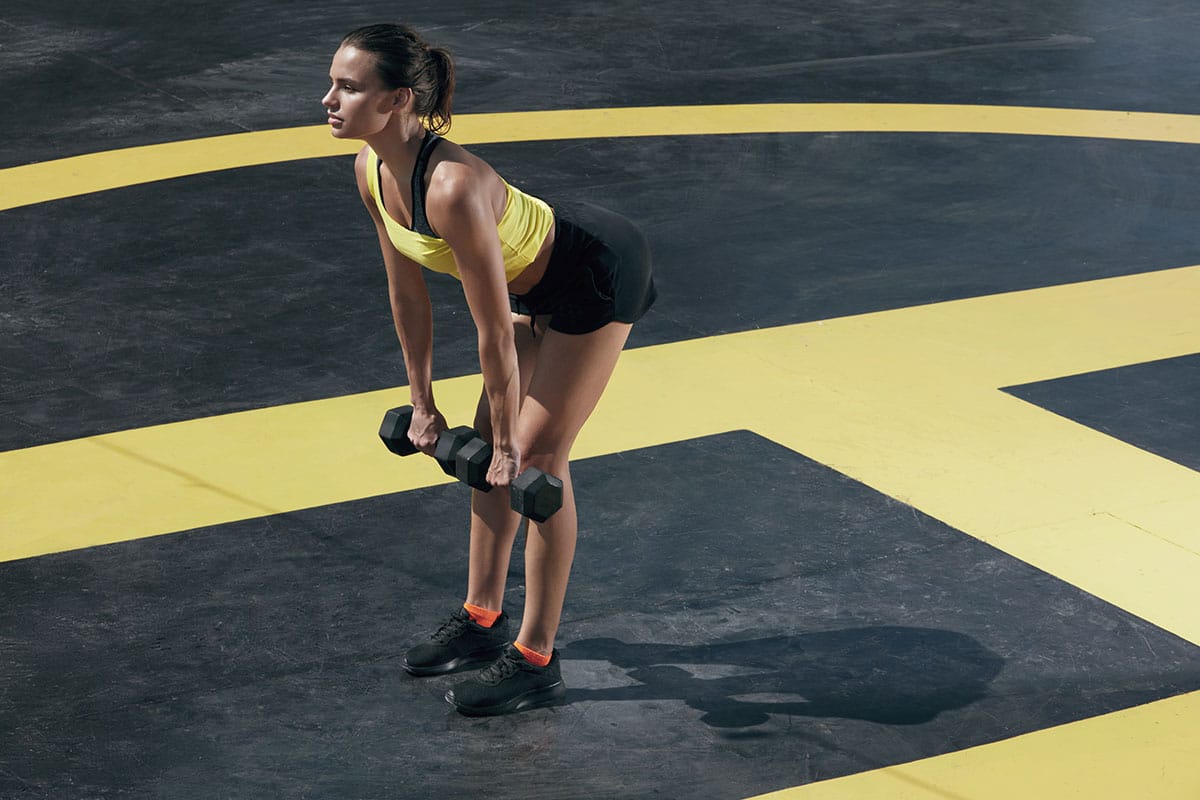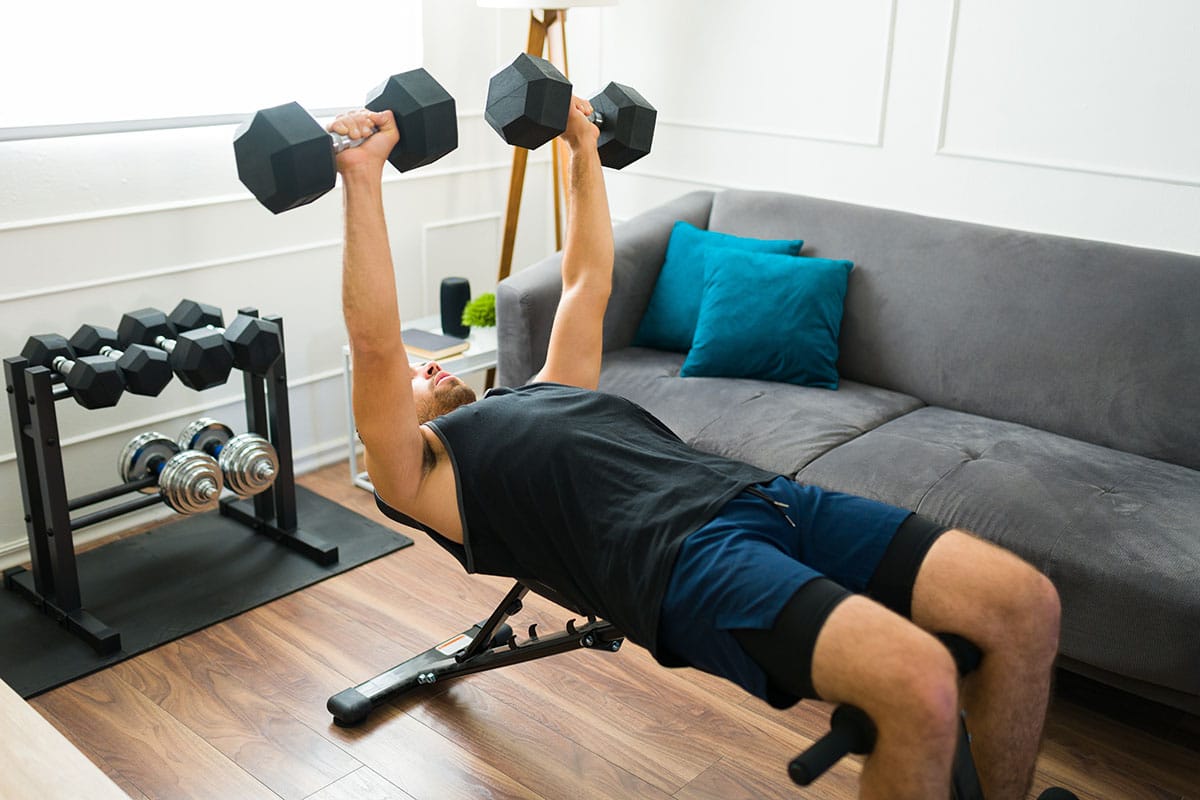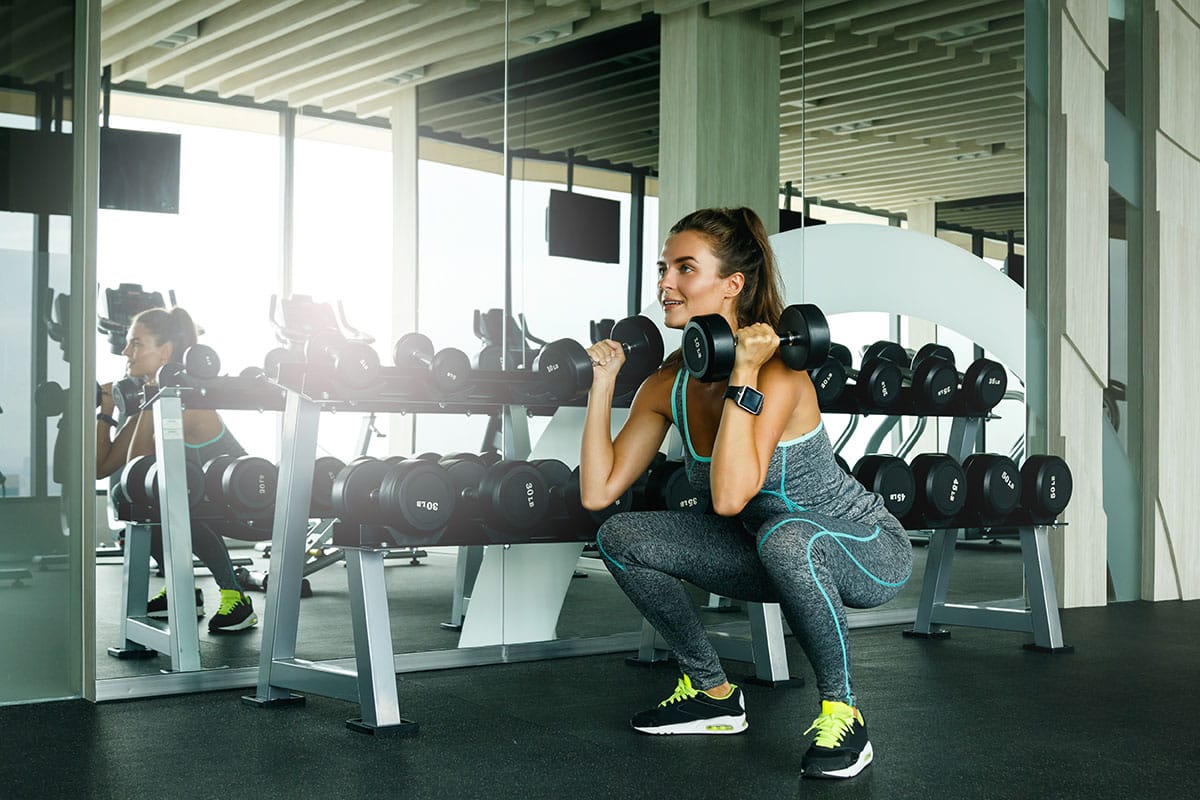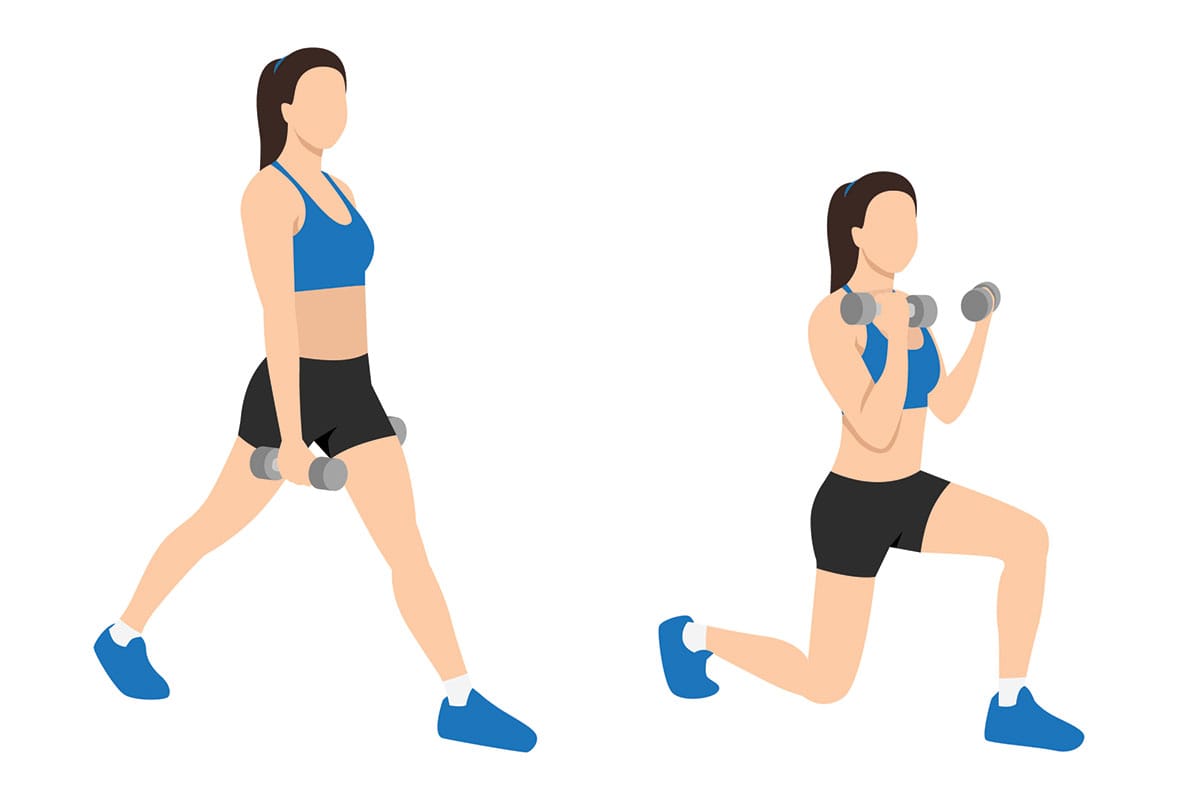Top 8 Compound Exercises With Dumbbells
Master compound exercises with dumbbells to tone your upper and lower body.
If you’ve been struggling to hit your PRs using massive barbell squats and deadlifts, it’s possible that you’re suffering from gym burnout!
But have you ever thought about switching up your weight type? This article will guide you through how to work on your compound lifts with dumbbells.
We’ll unveil how to tackle compound exercise techniques and why pairing compound exercises with isolation work should be an integral part of your weekly workout routine.
What is a Compound Exercise?
In case you need a quick refresher, compound exercises engage multiple muscle groups and joints simultaneously. Think of moves like your squats and deadlifts where the glutes, hamstrings, and quadriceps and both your hip and knee joints are working together.
Compound movements are fundamental to your strength training and functional fitness since they mimic everyday activities.
For example, when you squat down to pick up your grocery bags, you’re using a (hopefully lighter!) variation of a squat or deadlift position.
Using your gym time to strengthen the muscles that work in these lifts is beneficial for building up your everyday stability and improving overall muscle coordination and strength.
When we talk about compound exercises with dumbbells, we mean any compound lift that can be adapted to use a dumbbell or pair of dumbbells as your main weight source.
And there are a lot! We’ll talk about 5 of the most fundamental compound exercises with dumbbells next to give you some technique tips and a few ideas to build out a simple weekly workout split.
Top 8 Compound Exercises with Dumbbells
As mentioned, compound exercises target multiple muscle groups and joints simultaneously, making them effective for building overall strength and functional fitness. Here are five of the best compound exercises you can do with dumbbells:
1. Dumbbell Squats
The squat is the “king of exercises,” and this remains true as it is one of the best compound glute exercises no matter what equipment you use. Take a look at how to use dumbbells in your squat, swapping out the traditional barbell.

Muscles Worked: Quadriceps, hamstrings, glutes, lower back, core.
- Set-Up: Hold a dumbbell in each hand at your sides or braced on your shoulders. Stand with your feet shoulder-width apart.
- Action: Lower your body by bending your knees and hips. Keep your back straight throughout the movement as you bring your legs to a 90-degree bend.
- Reverse: Push through your heels to return to your standing start position.
- Reps: 3-4 sets of 8-12 reps
Pro-Tip: Focus on form. Dumbbells are a good option for a lighter squat if you find your technique has been suffering. For those with frequent hip pain when squatting or lower back pain when squatting, a dumbbell squat progression can be a great choice to sub in for the barbell back squat.
2. Dumbbell Deadlifts
Muscles Worked: Hamstrings, glutes, lower back, core, upper back.

- Set-Up: Hold a dumbbell in each hand, facing the front of your thighs.
- Body Position: Keep a slight bend in your knees and a straight back. Engage your core muscles.
- Action: Hinge from your hips to lower the dumbbells, thinking about sliding them down the front of your legs.
- Reverse: Come back to the starting position by driving your hips forward to stand up.
- Reps: 3-4 sets of 8-12 reps
Note: Dumbbell deadlift is one of the best compound core exercises you can try at home.
3. Dumbbell Bench Press
Muscles Worked: Chest, shoulders, triceps.

- Set-Up: Lie on a flat bench with a dumbbell in each hand hovering at chest level.
- Action: Press your dumbbells up until your arms are fully extended. Although the goal is to have straight arms at the top of this movement, make sure you don’t lock out your elbows.
- Reverse: Slowly lower your dumbbells back to the starting position. Repeat as needed.
- Reps: 3-4 sets of 8-12 reps.
Pro-Tip: Want to target more of your upper or lower chest? If you struggle with bad chest genetics, a decline or incline bench press may help you address your target areas more efficiently for better results and balanced growth. Learn about the best incline bench angle so you understand how to better work your chest muscles while you bench.
Understanding how to bench more can be a major factor in helping you build muscle, too!
4. Dumbbell Rows
Muscles Worked: Upper back, lats, biceps, core.

- Set-Up: Grab a dumbbell in each hand. Hinge forward from your hips, with a slight bend in your knees so your torso comes almost parallel to the ground.
- Action: Using your back to drive your movement forcefully but with control, pull the dumbbells towards your sides. Squeezing your shoulder blades together at the apex of the move.
- Reverse: With control, slowly lower your weights back down to complete one rep.
- Reps: 3-4 sets of 8-12 reps.
5. Dumbbell Overhead Press
Muscles Worked: Shoulders, triceps, upper chest, core.

- Set-Up: Hold a dumbbell in each hand at shoulder height.
- Body Position: Face your palms forward (pronated grip).
- Action: Press your dumbbells up above your head until your arms are extended fully.
- Reverse: Lower them with control back to your start position.
- Reps: 3-4 sets of 8-12 reps.
6. Dumbbell Squat to Press

- Set-Up: Hold a dumbbell in each hand, racked at your shoulders.
- Body Position: Stand tall with your feet shoulder-width apart or slightly wider. Keep your abdominals engaged and your shoulders back so your chest stays open.
- Action: Drop into a squat by bending your knees and hips to lower. Drive through your heels to stand while pressing the dumbbells overhead at the same time.
- Reverse: Lower the dumbbells back to your shoulders as you come back into your squat.
- Reps: 3-4 sets of 8-12 reps.
7. Renegade Row to Push-Up

- Set-Up: Start in a high plank position with a hexagonal dumbbell in each hand. You’ll need dumbbells with a flat edge so you can balance. Keep your feet shoulder-width apart.
- Body Position: Stay in a straight line from your head to your heels. Brace our core.
- Action: Row one dumbbell to your side, then lower it back down. Do a push-up in between and repeat the row with the other arm, then do another push-up. This cycle completes one full rep.
- Reps: 3-4 sets of 6-10 reps.
8. Dumbbell Lunge with Bicep Curl

- Set-Up: Hold a dumbbell in each hand at your sides, standing with your feet hip-width apart.
- Body Position: Stand up straight, engaging your core for balance. Keep your shoulders back and your arms straight down to begin.
- Action: Step forward into a lunge, dropping your back knee toward the floor and bringing your front knee to a 90-degree angle. As you stand back up, curl your dumbbells in toward your shoulders, flexing your biceps.
- Reverse: Lower your dumbbells back down as you step back to your start position.
- Reps: 3-4 sets of 8-10 reps per leg.
Why Should You Use Dumbbells Instead of Barbells?
Barbells help you lift heavier, right? And heavier weights mean more muscle gain, so theoretically, a barbell should take the cake.
Well, yes, but not in every situation. Here are a few benefits of dumbbells over barbells that may surprise you!
Range of Motion
Dumbbells give you a greater range of motion. Compared to a barbell, which you can move up and down, back and forward, or side to side, dumbbells also move in and out (meaning you can bring them to touch along the midline of your body, then separate them again).
This gives you a lot of versatility and can help enable effective muscle engagement and development.
Muscle Balance
Using dumbbells means you can move each side of your body independently. When you move from one side of the body, it’s called unilateral (vs. bilateral”) resistance training.
Training the sides of your body separately can help you correct muscle imbalances by ensuring both sides of the bodywork equally so you don’t become single-side dominant.
Stability and Coordination
Dumbbells require more stabilization. This works a lot of your little muscles, which are called “stabilizers,” and helps you get better at overall coordination and functional strength.
Tip: If you want to do different exercises with dumbbells, you need to know different types of dumbbells so you can choose the most suitable one for your budget or body.
Big Picture
Compound dumbbell exercises are fantastic because they engage multiple muscle groups at once, helping you build overall strength and improve functional fitness.
Your workouts get more efficient as you target several areas in a single move. Plus, they enhance your coordination and stability, which makes everyday tasks easier.
Whether you're squatting, deadlifting, or pressing, these exercises boost your metabolism, support muscle growth, and keep your workouts fun and challenging.
A simple pair of dumbbells can give you a full-body workout that leaves you feeling strong and energized!
Remember, it’s essential to track your progress in every exercise, whether you’re using dumbbells or barbells. That’s what you can do on the Flex Fitness app. Apart from tracking your PR, you can learn how to properly do each exercise, even if you don’t have a private trainer at a gym.
If you want to build your body in the most cost-effective way, give Flex Fitness a try.
References
Craig, B. W., Brown, R., & Everhart, J. (1989). Effects of progressive resistance training on growth hormone and testosterone levels in young and elderly subjects. Mechanisms of ageing and development, 49(2), 159–169. https://doi.org/10.1016/0047-6374(89)90099-7
Liaghat, B., Pedersen, J. R., Husted, R. S., Pedersen, L. L., Thorborg, K., & Juhl, C. B. (2023). Diagnosis, prevention and treatment of common shoulder injuries in sport: grading the evidence - a statement paper commissioned by the Danish Society of Sports Physical Therapy (DSSF). British journal of sports medicine, 57(7), 408–416. https://doi.org/10.1136/bjsports-2022-105674
Liao, K. F., Nassis, G. P., Bishop, C., Yang, W., Bian, C., & Li, Y. M. (2022). Effects of unilateral vs. bilateral resistance training interventions on measures of strength, jump, linear and change of direction speed: a systematic review and meta-analysis. Biology of sport, 39(3), 485–497. https://doi.org/10.5114/biolsport.2022.107024
Melanson SW, Shuman VL. Acute Ankle Sprain. [Updated 2023 May 23]. In: StatPearls [Internet]. Treasure Island (FL): StatPearls Publishing; 2024 Jan-. Available from: https://www.ncbi.nlm.nih.gov/books/NBK459212/
https://www.health.harvard.edu/staying-healthy/preserve-your-muscle-mass
Related articles


Get fit with Flex
Build muscle & lose weight fast for free.
Available on iPhone + Apple Watch





